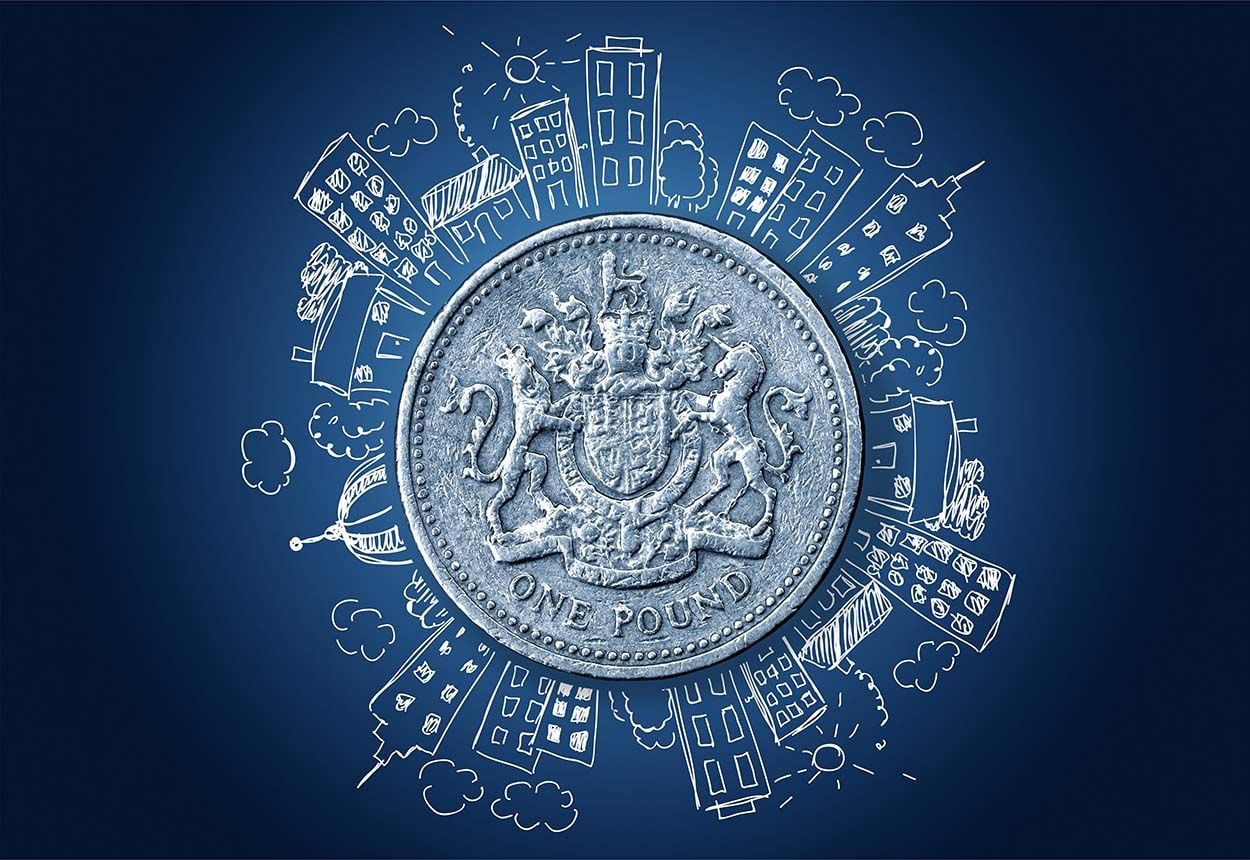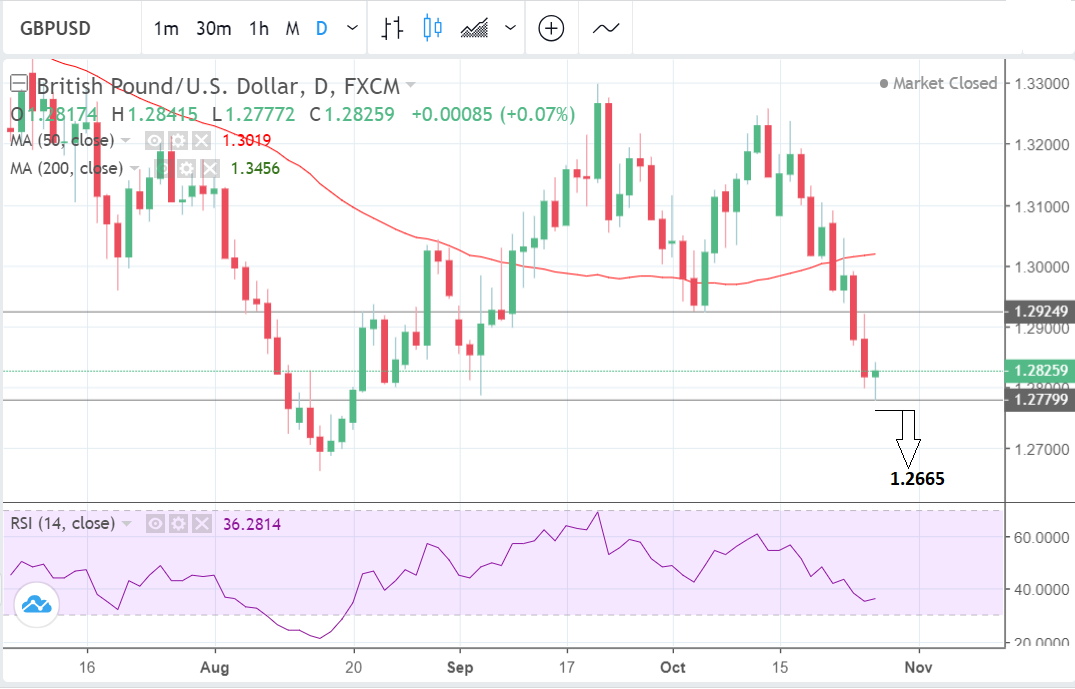The Pound-to-Dollar Rate in the Week Ahead: Downside Bias Remains in Place

© Adobe Stock
- The bears remain in control of the GBP/USD rate.
- August lows at 1.2665 are now the next stop for GBP.
- GBP eyes BOE interest rate meeting, payrolls for USD.
The Pound-to-Dollar rate fell to fresh lows of 1.2777 on Friday after solid growth data lifted the greenback while Sterling remained on its back foot due to unfavourable Brexit news-flow.
There is an old Wall Street saying that the "trend is your friend until the bend at the end," and so far we do not see a bend at the end of October's short-term downtrend.

Above: Pound-to-Dollar rate shown at daily intervals.
The pair found support at the monthly pivot of 1.2771 Friday and then bounced to eventually close the week at 1.2829.
The 1.2771 point will be a tough obstacle for the market to overcome and there is a risk of a reversal at that level. Short-term technical traders also often use pivots to make counter-trend raids on the market in anticipation of corrective moves.
We would ideally wish to see a clear break below 1.2771 before calling for an extended downtrend. A break of 1.2750 would open the door for a move down to 1.2665, and the August lows.
The RSI momentum indicator is falling in line with the exchange rate, which suggests the bears will remain in control for now. Moreover, the RSI is at the same level it was at back during the formation of the August lows, which could also indicate a propensity for further weakness.
Advertisement
Bank-beating exchange rates! Get up to 5% more foreign exchange by using a specialist provider to get closer to the real market rate and avoid the gaping spreads charged by your bank when providing currency. Learn more here
The Dollar: What to Watch
The big event for the Dollar in the week ahead is the nonfarm payrolls report due out on Friday at 13:30 London time.
October's payrolls are expected to show the U.S. economy creating 191k new jobs, up from 134k in the previous month.
The relatively weak September figure was put down to the effect of Hurricane Florence preventing people from turning up to work and given this, payrolls are expected to rebound.
"Hurricane Florence was largely to blame for the depressed job growth last month, however, as about 300,000 workers said they were unable to work due to bad weather. This is compared to an average of 85,000 workers in a typical September. Other indicators suggest no signs of a cooling labor market," says Diane Schumaker-Krieg, head of research at Wells Fargo.
The labour report is also forecast to show the unemployment rate rising to 3.8% in October, from 3.7% previously.
Probably as important as the headline payrolls figure will be the average hourly earnings number, which is expected to have risen 3.1% in October, up from 2.8% previously.
Such a rise in wages would be commensurate with an increasingly inflationary outlook, which in turn, would keep the Federal Reserve (Fed) on course to keep raising its interest rate.
Another key release in the week ahead is personal consumption expenditure (PCE), which is a type of inflation gauge, and the preferred measure of the Fed.
Core PCE inflation is expected to rise by 0.1% month-on-month in September from 0% previously. Year-on-year it is expected to rise by 2.0%, the same as in September.
"Continued strength in consumption partly reflects the boost to disposable incomes from tax cuts earlier this year. On Monday, we will receive September personal income and spending data. The strength exhibited in Q3 consumption, however, all but guarantees roughly a 0.3% nominal rise in personal spending for September," says Schumaker-Krieg.
The third major release in the week ahead is the ISM Manufacturing PMI, which is expected to decline to 59.0, from 59.3 previously when it is released on Thursday at 15.00.
The ISM reached a 14-year high in August before moderating in September. Analysts will be watching the data for signs of a continued slowdown that could be attributable to President Donald Trump's tariffs.
"Anecdotal evidence from respondents’ comments highlighted rising input costs and supply constraints attributable to tariffs and labor shortages starting to weigh on activity. We expect the ISM to further moderate to 59.1 in October, as manufacturers continue to face production constraints," says Schumaker-Krieg.
Advertisement
Bank-beating exchange rates! Get up to 5% more foreign exchange by using a specialist provider to get closer to the real market rate and avoid the gaping spreads charged by your bank when providing currency. Learn more here
The Pound: What to Watch
The main in the week ahead for the Pound is the Bank of England (BOE) interest rate announcement and quarterly inflation report, due on Thursday, 01 November at 13:00.
The BoE is not expected to change its interest rate so markets will focus on the contents of the inflation report and commentary from governor Mark Carney in order to gauge when the bank's next likely move on interest rates will come.
If the BoE's forecasts still show inflation remaining above its target in 2021 then Sterling may find support because markets would infer that the bank remains on course to keep raising interest rates over coming quarters.
Inflation rose to 2.7% in August, from 2.4%, when markets had looked for it to rise to only 2.5%. The recent rise in wages could also factor in the the BoE's forecasts, as that also supports expectations of higher inflation ahead.
Brexit remains the great unknown that might prevent the BoE from revealing its hand too much but assuming the government can agree to a transition period after March, the BOE is likely to raise interest rates again in May 2019 according to ING Group.
"If a majority of MPs approve the agreement in the Parliamentary vote (despite all the current bluster), then the UK will leave the EU on time in March and the transition phase will commence. This somewhat smoother outcome would keep the door open to a May rate hike," says James Knightley, an economist at ING.
Analysts at broker XM.com say the BOE will probably use Thursday's meeting to reiterate its forward guidance for 1-2 rate hikes per year over the next few years.
"It’s less probable that the BoE will modify its guidance of 1-2 rate increases per year over the next few years. The pound could firm slightly if Governor Mark Carney stresses in his press conference that the risks to inflation remain to the upside," says XM.com.
The Autumn budget statement on Monday at 13.30 is another event that could impact the Pound during the week ahead. Economic growth forecasts and government spending plans will have an impact on both bond and currency markets.
UK Manufacturing and Construction PMI's are also due out in the week ahead, with both likely to impact expectations for fourth-quarter economic growth. The manufacturing PMI is expected to fall to 53.0 for October, from 53.8 previously. The construction PMI is seen declining from 52.1 to 52.0.
Advertisement
Bank-beating exchange rates! Get up to 5% more foreign exchange by using a specialist provider to get closer to the real market rate and avoid the gaping spreads charged by your bank when providing currency. Learn more here




